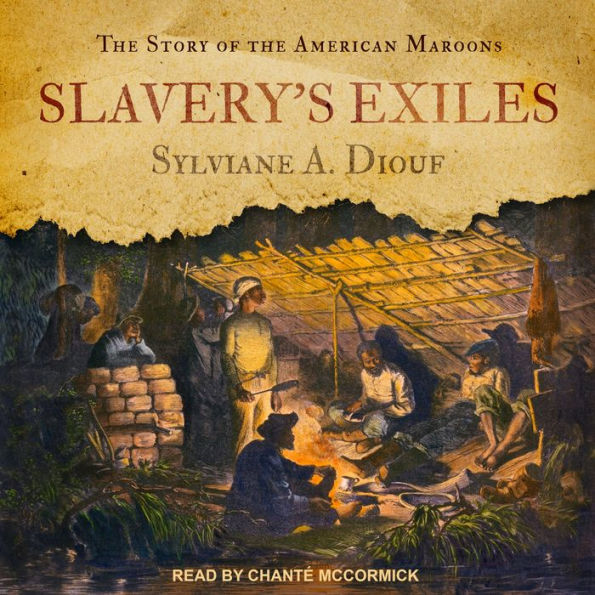"In a book that is easily accessible yet rigorously researched, analyzed, and argued, Diouf has made a compelling case that scholars of slavery and of early American history must consider the presence of maroons in the U.S. with a sense of renewed urgency. As she so eloquently and brilliantly shows, maroons exhibited a form of self-determined, autonomy-seeking resistance to slavery that complicates our understanding of fugitivity and freedom as they are generally bound up in a North/South, free/unfree binaristic imaginary."
The forgotten stories of America maroons¿wilderness settlers evading discovery after escaping slavery
Over more than two centuries men, women, and children escaped from slavery to make the Southern wilderness their home. They hid in the mountains of Virginia and the low swamps of South Carolina; they stayed in the neighborhood or paddled their way to secluded places; they buried themselves underground or built comfortable settlements. Known as maroons, they lived on their own or set up communities in swamps or other areas where they were not likely to be discovered.
Although well-known, feared, celebrated or demonized at the time, the maroons whose stories are the subject of this book have been forgotten, overlooked by academic research that has focused on the Caribbean and Latin America. Who the American maroons were, what led them to choose this way of life over alternatives, what forms of marronage they created, what their individual and collective lives were like, how they organized themselves to survive, and how their particular story fits into the larger narrative of slave resistance are questions that this book seeks to answer. Audacious, self-confident, autonomous, sometimes self-sufficient, always self-governing; their very existence was a repudiation of the basic tenets of slavery.
1115290783
Over more than two centuries men, women, and children escaped from slavery to make the Southern wilderness their home. They hid in the mountains of Virginia and the low swamps of South Carolina; they stayed in the neighborhood or paddled their way to secluded places; they buried themselves underground or built comfortable settlements. Known as maroons, they lived on their own or set up communities in swamps or other areas where they were not likely to be discovered.
Although well-known, feared, celebrated or demonized at the time, the maroons whose stories are the subject of this book have been forgotten, overlooked by academic research that has focused on the Caribbean and Latin America. Who the American maroons were, what led them to choose this way of life over alternatives, what forms of marronage they created, what their individual and collective lives were like, how they organized themselves to survive, and how their particular story fits into the larger narrative of slave resistance are questions that this book seeks to answer. Audacious, self-confident, autonomous, sometimes self-sufficient, always self-governing; their very existence was a repudiation of the basic tenets of slavery.
Slavery's Exiles: The Story of the American Maroons
The forgotten stories of America maroons¿wilderness settlers evading discovery after escaping slavery
Over more than two centuries men, women, and children escaped from slavery to make the Southern wilderness their home. They hid in the mountains of Virginia and the low swamps of South Carolina; they stayed in the neighborhood or paddled their way to secluded places; they buried themselves underground or built comfortable settlements. Known as maroons, they lived on their own or set up communities in swamps or other areas where they were not likely to be discovered.
Although well-known, feared, celebrated or demonized at the time, the maroons whose stories are the subject of this book have been forgotten, overlooked by academic research that has focused on the Caribbean and Latin America. Who the American maroons were, what led them to choose this way of life over alternatives, what forms of marronage they created, what their individual and collective lives were like, how they organized themselves to survive, and how their particular story fits into the larger narrative of slave resistance are questions that this book seeks to answer. Audacious, self-confident, autonomous, sometimes self-sufficient, always self-governing; their very existence was a repudiation of the basic tenets of slavery.
Over more than two centuries men, women, and children escaped from slavery to make the Southern wilderness their home. They hid in the mountains of Virginia and the low swamps of South Carolina; they stayed in the neighborhood or paddled their way to secluded places; they buried themselves underground or built comfortable settlements. Known as maroons, they lived on their own or set up communities in swamps or other areas where they were not likely to be discovered.
Although well-known, feared, celebrated or demonized at the time, the maroons whose stories are the subject of this book have been forgotten, overlooked by academic research that has focused on the Caribbean and Latin America. Who the American maroons were, what led them to choose this way of life over alternatives, what forms of marronage they created, what their individual and collective lives were like, how they organized themselves to survive, and how their particular story fits into the larger narrative of slave resistance are questions that this book seeks to answer. Audacious, self-confident, autonomous, sometimes self-sufficient, always self-governing; their very existence was a repudiation of the basic tenets of slavery.
24.99
In Stock
5
1

Slavery's Exiles: The Story of the American Maroons

Slavery's Exiles: The Story of the American Maroons
FREE
with a B&N Audiobooks Subscription
Or Pay
$24.99
24.99
In Stock

Editorial Reviews
Product Details
| BN ID: | 2940175388856 |
|---|---|
| Publisher: | Tantor Audio |
| Publication date: | 05/31/2022 |
| Edition description: | Unabridged |
Videos

From the B&N Reads Blog
